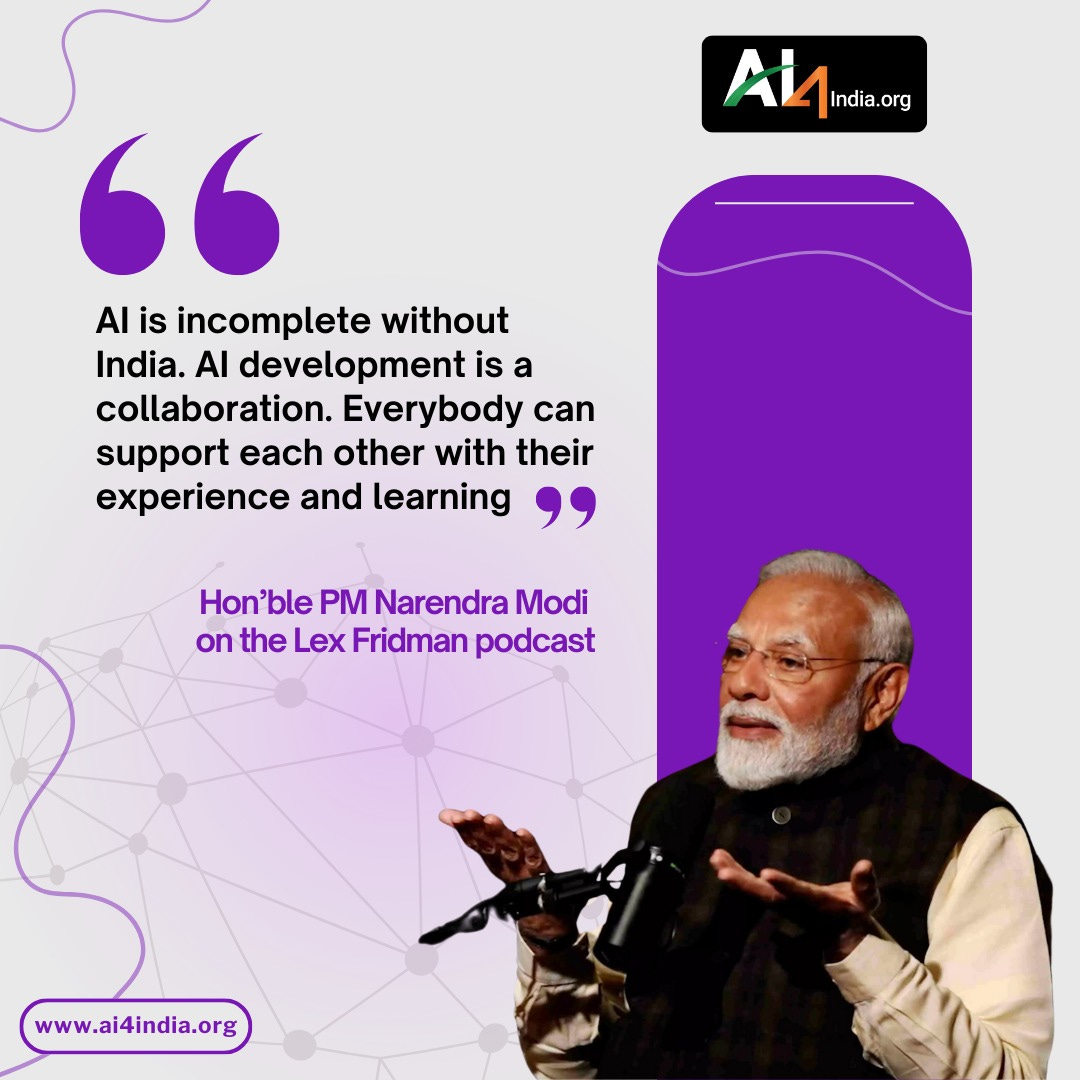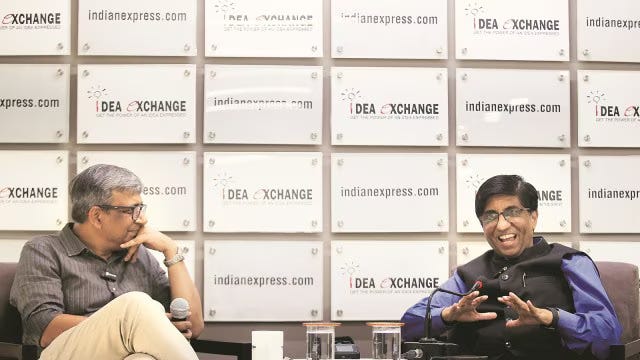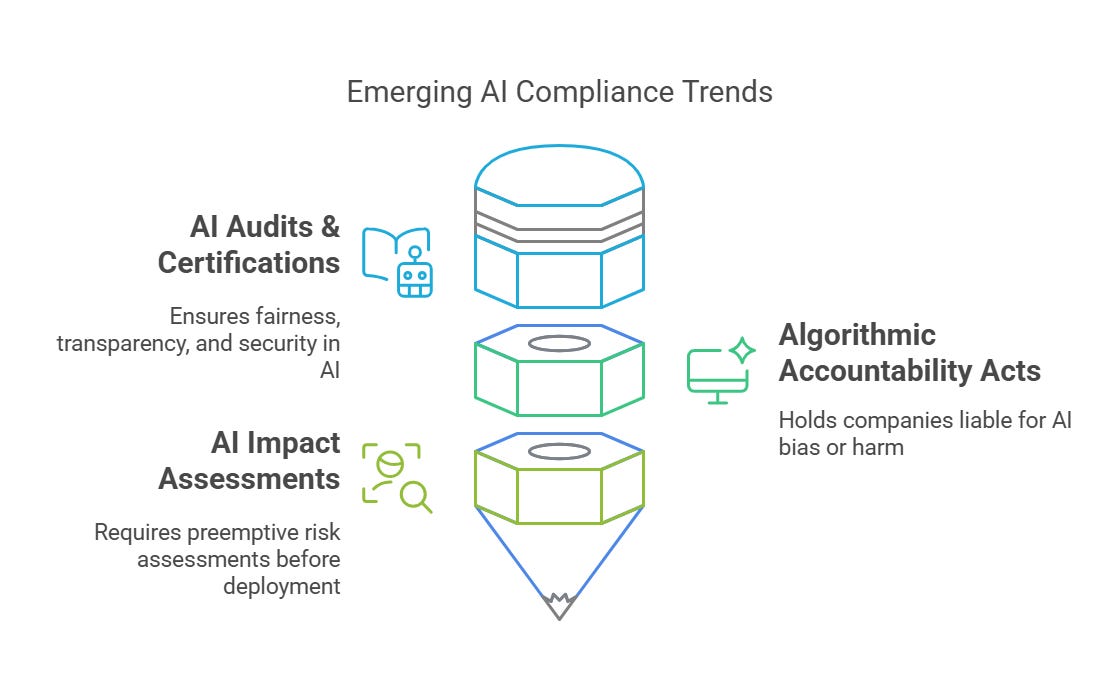Powering AI with Purpose: Insights from PM Modi and India’s AI Leaders
The AI4India Weekly #44
Prime Minister Narendra Modi’s powerful assertion that “no technology can replace human imagination” has sparked a timely conversation on the role of AI in shaping India’s future. From advocating AI as a force for inclusive development to stressing the need for ethical governance and global collaboration, PM Modi’s recent remarks underscore India’s commitment to using AI as a tool to amplify—not replace—human creativity. As India’s AI ecosystem evolves rapidly—from homegrown language models to critical debates on data strategy and compliance—this week brings fresh insights into the people, policies, and innovations powering AI for public good.
PM Modi on AI and Human Creativity: "No Technology Can Replace Human Imagination"
In a wide-ranging conversation on Lex Fridman's global podcast, Prime Minister Narendra Modi offered key insights into India’s vision for artificial intelligence. Addressing the growing influence of AI, PM Modi made a significant remark: "No technology can ever replace human creativity and imagination." While acknowledging AI’s transformative potential, he emphasized that technology should serve as a tool for empowerment, not a replacement for human agency.
Highlighting India’s approach, the Prime Minister spoke about leveraging AI for inclusive development, particularly in agriculture, healthcare, education, and governance. He stressed the need for ethical AI development, data privacy, and global collaboration to ensure AI benefits all of humanity. The conversation underscored India's belief in AI for public good—a tool to amplify human potential, not diminish it.
As India rolls out AI-led initiatives and policies, PM Modi’s message is clear: Let technology enhance, not eclipse, the uniquely human spark.
AI4Bharat: Powering the Future of Indian Language AI – Open, Scalable, and Homegrown
For over four years, AI4Bharat has been at the forefront of building cutting-edge AI tools and models for Indian languages, firmly grounded in open-source principles. Backed by support from EkStep Foundation, Nilekani Philanthropies, and Bhashini (Ministry of Electronics and IT), the initiative has now made all its pioneering contributions available on Hugging Face, driving collaboration and innovation across India’s AI ecosystem.
From machine translation and speech recognition to text-to-speech and large language models (LLMs), AI4Bharat is transforming how AI engages with India’s linguistic diversity.
Machine Translation (MT)
IndicTrans2: First MT model supporting all 22 constitutionally recognized Indian languages, trained on BPCC, the largest bilingual corpus with 250M+ sentence pairs.
IndicTrans3-beta: Features document-level translation for more context-aware outputs.
IndicSeamless-13: A speech-to-text translation model delivering state-of-the-art accuracy on Indian language benchmarks.
Automatic Speech Recognition (ASR)
IndicVoices & Kathbath: Large, diverse speech datasets from 308 districts in 22 languages.
IndicConformer: India’s first open-source ASR supporting all 22 official languages—fast, accurate, and free to use.
Shrutilipi & Lahaja: Rich resources for training and evaluating multi-accent ASR systems.
Text-to-Speech (TTS)
IndicParler-TTS: The first open-source TTS for all 22 Indian languages, converting text prompts into expressive speech.
IndicF5: A polyglot AI for generating speech in 11 Indian languages using adaptable licensed voices.
Indic Large Language Models (LLMs)
Airavata: A fine-tuned chat LLM for Hindi, enabling rich conversational AI.
IndicLLMSuite: A comprehensive toolkit for developing Indic LLMs, including evaluation datasets like FBI and CIA to benchmark performance.
With their models now live and freely available, AI4Bharat is inviting developers, researchers, and enthusiasts to try out, improve, and deploy these tools to advance AI accessibility in Indian languages.
Unlocking India’s AI Potential: Why a Robust Data Strategy for Foundational Models Is Urgent
India’s aspirations to lead in AI hinge not just on innovation in algorithms or hardware—but on strategic access to high-quality datasets, particularly for developing foundational models tailored to Indian needs. A recent Economic Times CIO piece highlights the critical need for a national data strategy to power AI development across sectors.
While India boasts vast and diverse data, much of it remains fragmented, inaccessible, or unstructured, limiting the ability to train domain-specific and multilingual AI models. To bridge this gap, experts emphasize the importance of public-private partnerships to create curated, annotated datasets—especially in sectors like healthcare, agriculture, and governance—while ensuring privacy, security, and ethical use.
With global players racing ahead, India must prioritize building data infrastructures that support open innovation and localized AI models. Initiatives like Bhashini and Data Daan are steps in the right direction, but a comprehensive national framework is essential to democratize data access and unlock the full potential of AI for India’s socio-economic growth.
India Must Lead with Disruptive AI Solutions: Prof. Abhay Karandikar
In a compelling conversation at The Indian Express’s Idea Exchange, Secretary of the Department of Science & Technology (DST) Prof. Abhay Karandikar emphasized the urgent need for India to develop “disruptive and game-changing” solutions in emerging technologies like AI. He argued that technological self-reliance is not enough—India must aim to lead innovation globally, especially in critical areas such as generative AI, quantum computing, and AI-driven healthcare.
On AI regulation, Prof. Karandikar stressed balance, noting that too much regulation can stifle innovation, while no regulation can raise ethical and security concerns. He advocated for a “light-touch” approach—one that guides innovation while protecting public interest. He also highlighted India’s diverse and massive datasets as a unique strength, calling for greater investments in data infrastructure to support India-specific AI models.
Prof. Karandikar’s vision aligns with the government’s broader goal of ensuring that India is not just a consumer of global tech but a creator of frontier technologies tailored to local and global needs.
Read the full interview here.
Dr. Shivkumar Kalyanaraman Takes Charge as CEO of ANRF
Dr. Shivkumar Kalyanaraman has officially assumed charge as the Chief Executive Officer (CEO) of the Anusandhan National Research Foundation (ANRF), taking over from Prof. Abhay Karandikar, Secretary, DST, who had been serving in an acting capacity. With a mission to seed, grow, and promote cutting-edge research across India’s academic and R&D institutions, ANRF is envisioned as the apex body for steering India’s scientific research agenda, in line with the National Education Policy (NEP).
Dr. Shivkumar brings with him decades of experience in technology and innovation, having served as Chief Technology Officer (CTO) for the Energy Industry in Asia at Microsoft. An alumnus of IIT Madras and Ohio State University, he is widely recognized in the global tech community—Fellow of IEEE and INAE, ACM Distinguished Scientist, and TR100 Young Innovator. His appointment signals a strategic push to forge stronger industry-academia-government collaborations and drive India’s R&D ecosystem toward global leadership.
AI Compliance in 2025: How Tech Teams Can Stay Ahead of Global Regulations
As AI governance tightens worldwide, organizations must rethink their compliance and risk strategies
By Deepalakshmi Vadivelan & Adarsh Lathika | AI Policy & Compliance Experts
The AI Opportunity—And the Compliance Challenge
Artificial Intelligence is no longer a futuristic concept—it is deeply embedded in business strategy, product development, and operational decision-making. From AI-powered analytics to generative models, organizations are harnessing AI to drive efficiency and competitive advantage.
However, with AI adoption comes regulatory scrutiny. Governments worldwide are enacting stricter AI governance frameworks, imposing legal and ethical responsibilities on organizations deploying AI systems.
India’s Digital Personal Data Protection Act (DPDPA) 2023 is now in effect, requiring organizations to rethink data collection, security, and AI governance.
The EU AI Act is setting global standards for AI risk classification and transparency.
The U.S. AI Bill of Rights and recent executive orders emphasize responsible AI use.
China’s AI regulatory framework places restrictions on generative AI models and cross-border data flows.
For senior technology leaders, compliance officers, and policymakers, the challenge is clear: How can organizations ensure AI-driven innovation while remaining compliant with evolving laws?
This article outlines key regulatory trends and what tech teams must do to stay ahead.
AI Governance Priorities for Organizations in 2025
Data Collection & User Consent – Moving Toward "Informed AI"
AI systems thrive on vast datasets, but new laws mandate purpose-specific data collection and explicit user consent. Organizations can no longer rely on broad, ambiguous privacy policies.
What organizations must do:
Implement granular, opt-in consent mechanisms that allow users to control how their data is used in AI models.
Store detailed consent logs, ensuring auditability and transparency.
Provide real-time data control dashboards for users to manage or withdraw consent easily.
📌 Strategic impact: Building AI systems that prioritize consent enhances regulatory compliance while reinforcing customer trust and brand credibility.
AI Model Transparency – No More "Black Boxes"
Governments are increasingly requiring AI-driven decisions to be explainable and accountable—particularly in finance, healthcare, hiring, and law enforcement. The era of "black-box" AI is over.
What organizations must do:
Adopt explainable AI (XAI) methodologies that allow human oversight and intervention.
Maintain AI audit logs that document how models process data and arrive at decisions.
Conduct bias and fairness assessments to prevent discriminatory AI outcomes.
📌 Strategic impact: Organizations that embrace AI transparency will gain a competitive edge by aligning with ethical AI expectations and regulatory best practices.
AI Security & Data Protection – Strengthening the Compliance Shield
AI systems are prime targets for cyberattacks, data breaches, and adversarial manipulations. Regulators now demand stronger AI security measures, including encryption, access control, and breach preparedness.
What organizations must do:
Encrypt AI-generated data at rest (AES-256) and in transit (TLS 1.3+).
Implement zero-trust architecture with role-based access controls (RBAC) for AI system interactions.
Deploy real-time monitoring and automated incident response systems.
📌 Strategic impact: Strengthening AI security will not only ensure compliance but also prevent reputational and financial risks associated with AI breaches.
AI & Data Localization – Navigating Cross-Border Data Challenges
Several countries—including India, China, Brazil, and the EU—now require AI-related data to be stored within national borders unless explicit exemptions apply. This is reshaping how global organizations approach AI infrastructure.
What organizations must do:
Localize AI training data where required to comply with jurisdictional mandates.
Implement data anonymization techniques to minimize regulatory risk when transferring AI datasets across borders.
Ensure data sovereignty compliance by using regional cloud storage and processing centers.
📌 Strategic impact: Companies that proactively adopt localization strategies will avoid disruptions and regulatory penalties when operating across multiple jurisdictions.
AI Risk & Breach Reporting – The 72-Hour Compliance Deadline
Under regulations like DPDPA and GDPR, organizations must now report AI-related data breaches within 72 hours—a critical shift requiring rapid response mechanisms.
What organizations must do:
Deploy Security Information & Event Management (SIEM) tools for real-time AI security monitoring.
Establish a clear AI incident response framework, defining reporting workflows and legal obligations.
Conduct regular AI risk assessments to mitigate vulnerabilities before regulatory scrutiny.
📌 Strategic impact: A proactive AI risk management framework will help organizations meet compliance deadlines while minimizing financial and legal exposure.
Vendor & Third-Party AI Compliance – Extending Accountability Beyond Your Walls
Regulators are now holding organizations responsible for AI compliance across their supply chains. If a third-party AI tool violates compliance laws, the company deploying it could face legal liability.
What organizations must do:
Conduct due diligence on third-party AI vendors before integration.
Include AI governance clauses in vendor contracts, ensuring compliance with DPDPA, GDPR, and other applicable laws.
Require third-party audits of AI tools used within organizational infrastructure.
📌 Strategic impact: Organizations that proactively assess AI vendor compliance will reduce third-party risks and regulatory exposure.
Looking Ahead: What’s Next in AI Regulation?
AI governance is moving toward greater accountability, transparency, and ethical oversight. Some key trends to watch:
AI Audits & Certifications: Regulatory bodies may require organizations to obtain certifications for AI fairness, transparency, and security before launching products.
Algorithmic Accountability Acts: Governments are considering legislation to hold companies liable for AI bias or harm, particularly in high-risk applications.
AI Impact Assessments: New mandates could require companies to conduct preemptive risk assessments before deploying AI models affecting consumers.
To stay ahead, C-suite leaders, compliance officers, and technology teams must integrate AI risk governance into their strategic decision-making frameworks.
Final Thoughts: The Compliance Imperative in AI Innovation
AI is driving the next wave of digital transformation, but compliance is now a core pillar of responsible AI deployment.
Organizations that embed AI compliance into their operational DNA will not only reduce legal risks but also strengthen consumer trust, investor confidence, and market leadership.
The message for AI-driven organizations in 2025 is clear: Proactive compliance is no longer an option—it’s a business necessity.
How is your organization preparing for AI compliance? Let’s discuss in the comments.
About the Authors
Deepalakshmi Vadivelan is a General Counsel and Global DPO with over two decades of experience, currently volunteering in AI technology policy. Passionate about responsible AI adoption, she advises organizations on AI compliance, data protection, and regulatory strategy.
Adarsh Lathika explores how 'work' as we know will evolve in response to technology and how that will impact the relationship between employer & an employee . He is studying anthropology & neuroscience for its impact in positivity, productivity and wellbeing. He shares his understanding in the 'Anatomy of Work' LinkedIn newsletter.
AI Buzz of the Week: What is Vibe Coding?
Imagine telling your computer what you want it to do in plain language—and it just gets it. That’s the idea behind Vibe Coding—a new way of programming where natural language prompts and AI tools handle the heavy lifting of code creation, letting users focus on ideas and “vibes” rather than syntax and logic.
At its core, Vibe Coding relies on Large Language Models (LLMs) and AI copilots to translate human intentions into functional code, enabling non-programmers to engage in software creation. This democratizes coding, making it more accessible, faster, and even collaborative. Think of it as “coding without coding”—a new creative workflow driven by AI.
Curious about how Vibe Coding could change who builds the digital world? Dive into this piece by The New Stack: 🔗 Vibe Coding: Where Everyone Can Speak Computer Programming
#DataDaan - Donate for a Digital India
Aligned with the IndiaAI Mission and MeitY’s efforts to ensure the availability of AI-usable data, the #DataDaan campaign by AI4India is now live on DataDaan.org. This initiative invites individuals and organizations to contribute valuable datasets, enriching India’s AI ecosystem and driving innovation across sectors. The platform provides a streamlined process for data contribution, ensuring responsible and impactful AI development. Visit DataDaan.org to explore the initiative and be part of this transformative effort.
NOTE: The views expressed by the authors are their own. AI4India as a forum does not endorse any comments on specific brands, products, platforms or companies.
Join our AI4India.org forum to be a part of the AI revolution in India by visiting our site now.
Follow us on our X and LinkedIn to receive interesting updates and analysis of AI-related news









